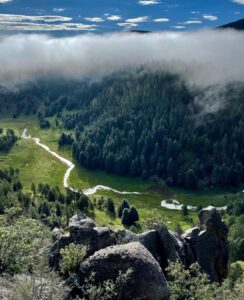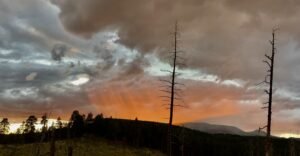
Words and photos by Garrett VeneKlasen, New Mexico Wild Northern Conservation Director
I was climbing up a long and steep hill in the Valles Caldera backcountry when I stumbled upon this beautiful elk antler. Tired and thirsty from the long climb, I sat down to gaze upon the antler. Towering Douglas fir trees outlined the distant view of the Valle Grande and the whole setting was profoundly spiritual to me.
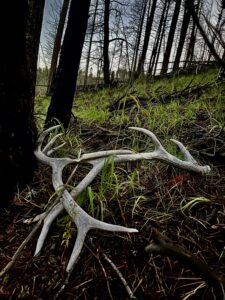
The bull elk dropped this antler sometime in early spring. After a long and tedious winter, the elk moved up out of its lowland wintering grounds – somewhere perhaps in Bandelier. No doubt the bull was tired and thin from an exhausting rut, followed by months of challenging foraging conditions in the deep snows of last winter.
Increasing daylight and decreasing testosterone caused the bull’s antlers to shed. Within days of falling off the elk’s head, new antlers covered in capillary-dense velvet started to regrow from the bleeding pedicle that was exposed when the antler fell off. In five short months, the bull re-grew an entire set of antlers. Imagine the physical feat it must take to grow two four-foot bone appendages that weigh about 12 pounds each. It would be like growing an entire leg in the same amount of time.
I contemplate the eons of antler evolution that formed its current shape – how elk and other cervids evolved to grow antlers purely as manifestations of their physical health and genetic prowess. Big, symmetrical antlers show cow elk what robust and healthy genetic specimens a bull is. Each specific elk’s antler is unique to that particular animal and individual points grow in the same specific configuration each year.
The hillside upon which the antler rests is the rim of a massive 2.5 million-year-old supervolcano. When the mountain erupted it was an apocalyptic place for perhaps thousands of years. Slowly over time, the land healed. Vegetation eventually grew back and the animals eventually returned. Many of those animals that returned after the eruption, especially the megafauna like cave bears and saber-toothed cats, are long extinct now.
The supervolcano’s dark earth now grows nutrient-rich grass, which the elk converts into antlers. The elk then sheds and regrows these antlers each year and they increase considerably in size with each passing season, until the elk turns ten years old or so. After that, the elk’s antlers shrink each year after the bull reaches his prime.
The elk and other wild creatures of this place live purely in the moment. They exist within a scope of unfettered intentionality and authentic, singular purpose. They do not think about yesterday and do not think about tomorrow, just the very moment in which they exist. And in that moment they are remarkably present and entirely un-self-conscious. They exist as purely visceral beings. Think about how enviable this must be, as we humans are backward and forward thinkers and therefore easily lose touch with ourselves and forget how to simply be completely present in the here and now.
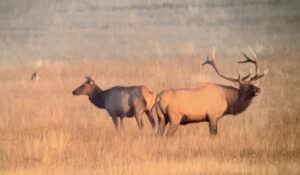
Elk thrived here for millennia until we colonists wiped them all out in a matter of decades. They were re-introduced at the turn of the last century, and now again thrive despite facing great adversity, both in the long and short term.
While we were extirpating the elk, we also killed all the grizzly bears and wolves here. I think about what this place must have been like before colonization when indigenous peoples were here hunting alongside these big apex predators, and how it is now so much less than without them here.
A huge fire raged across the Caldera a decade ago. The place was laid to waste. I remember like it was yesterday looking upon the mountain as nearly the whole range was ablaze – how the whole mountain glowed at night and looked like it probably did post-volcanic eruption.
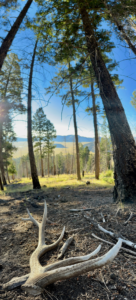 Today, deep grass and forbs have grown up out of the scorched earth. The burned conifers and aspens have mostly fallen. They are covered in fruiting fungi, which will break down the fallen trees to enrich the soil to grow more vegetation and eventually even more trees.
Today, deep grass and forbs have grown up out of the scorched earth. The burned conifers and aspens have mostly fallen. They are covered in fruiting fungi, which will break down the fallen trees to enrich the soil to grow more vegetation and eventually even more trees.
Icons of the season are abundant here in the high country. The first frost. The first snowflake. The first green, and then the first wildflower. The first butterfly. The first bumblebee. The first aspen leaf to turn yellow is brought on by the first frost, which signals the peak of the annual elk rut.
Shed antlers are classic icons of the season as well. But they are more than this – they are durable symbols of time, place, and the annual life cycle of a single animal that sheds and grows each unique set of antlers to display their physical prowess to a prospective mate and use these antlers to fight with the other bulls. And all the while he sings his plaintive and beautiful bugles that echo off the rim of a 2.5 million-year-old supervolcano.
When I was born, the world had a total population of 3.5 billion. Today 8 billion humans are living on this fragile planet. I think of the destruction we have wrought on this beautiful place just in my short life – all in the name of dominion, progress, and unfettered propagation.
I think there is still time to heal this planet and stop taking it for granted. There is still time to curb our obsessive, unsustainable, wasteful lifestyles. I think there is still time to learn to change this behavior and live sustainably. I think there is still time to treat this planet with the respect and sanctity it deserves. I think it is our moral duty to permanently conserve, preserve, and protect what is left of the wild places, precious watersheds, and iconic landscapes that remain untamed and undeveloped.
A bull elk bugles again far off in the timber above me. I stand and gaze down on that magical antler, and then up at the towering Douglas firs and into the belly of the magnificent extinct supervolcano. I once again begin my climb deeper into the stunning wild backcountry of the Valles Caldera National Preserve, doing my best to be completely in the moment. Taking it all in like a water-deprived desert in the middle of a summer thunderstorm.
